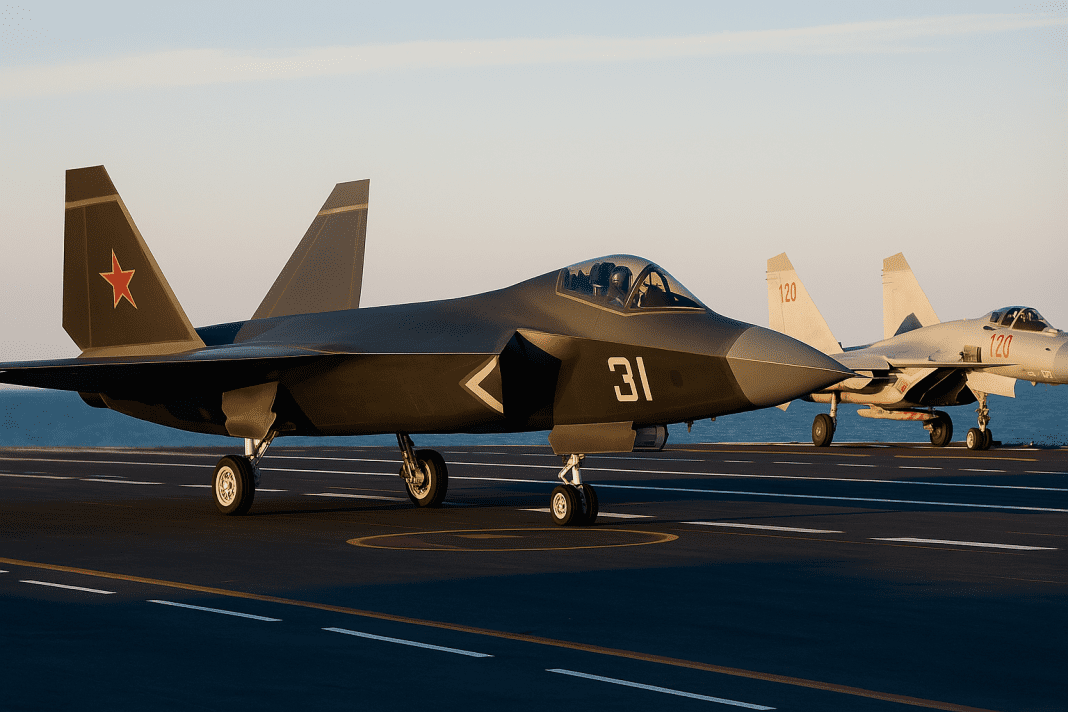For nearly a decade, the U.S. Navy enjoyed uncontested superiority at sea with the F-35C, the world’s first and only carrier-based fifth-generation stealth fighter. That monopoly is now broken. China has successfully deployed its own fifth-generation stealth aircraft, the Shenyang J-35, on its aircraft carriers — marking a new chapter in naval aviation history.
This major leap shifts the dynamics of sea-based air power in the Indo-Pacific region and beyond. China’s growing naval aviation capabilities have now entered a phase where they can realistically challenge the United States Navy — not only in numbers but also in stealth technology and range.
A Stealth Fighter for the Sea
The Shenyang J-35, also referred to as FC-31 in earlier stages, has officially entered service aboard Chinese aircraft carriers. Until recently, only the U.S. Navy could launch stealth fighters from sea. Now, China’s People’s Liberation Army Navy (PLAN) has successfully bridged that gap.
While the F-35C has been in combat service with the U.S. Navy since 2019, the J-35 has just made its appearance in operational photos circulating on Chinese platforms. These images show the new jet in flight, displaying navy-style tail numbers and the shark-mouth insignia seen on other carrier-borne Chinese aircraft.
This deployment confirms months of speculation and satellite imagery that hinted at high-intensity tests aboard China’s third aircraft carrier, the Fujian, which is currently undergoing sea trials. Experts believe the J-35 will be permanently stationed aboard this new-generation carrier — once it is fully commissioned — and potentially the fourth carrier under construction, rumored to be nuclear-powered.
✈️ Game Over for Stealth? India’s Radar Detects F-35, China’s J-35 Faces Reality Check
How the J-35 Breaks the Monopoly
Until now, the U.S. was the only power to possess stealth capability at sea. This gave it unmatched advantages in detection evasion, surprise attacks, and air dominance. The F-35C — with its longer wings, advanced sensors, and superior electronic warfare systems — had no counterpart on any rival carrier.
That advantage has officially ended.
Although the J-35 remains untested in real combat, its presence aboard PLAN carriers sends a clear signal: China is closing the gap not only in platform numbers but in frontline combat technology. And fast.
According to Western intelligence estimates, China is capable of producing up to 100 J-35s annually, thanks to its massive 270,000-square-meter production facility in Shenbei New District. This pace far exceeds the production capabilities of most Western defense firms. If this scale continues, the Chinese Navy could quickly match — or even outpace — the number of carrier-based stealth fighters the U.S. currently fields.
Carrier Presence and Future Intentions
The United States operates 11 nuclear-powered aircraft carriers, more than any other nation. These are globally deployed and integrated into U.S. military alliances. China, by contrast, has two conventionally powered carriers in active service — Liaoning and Shandong — with Fujian expected to join the fleet soon.
However, China’s strategy is not simply to match numbers. Its dual-carrier operations in the Pacific in mid-2025 were a strong indication of its ability to coordinate large-scale naval exercises. These drills saw Liaoning and Shandongoperating side by side, launching sorties and simulating sea control missions. For the first time, China flexed its naval muscles with a tone of quiet confidence.
China Enters the Next Era of Naval Power as Reports Suggest J-35B EMALS Launch from Fujian
If the J-35s are successfully integrated into this carrier force, it marks a historic step — China’s first genuine blue-water stealth air power projection.
Key Shifts to Watch
- Technology Convergence: The U.S. Navy’s advantage in stealth is now contested. The technological edge is no longer absolute.
- Production Scale: China’s aircraft manufacturing capacity is scaling faster than expected, driven by military-industrial momentum.
- Carrier Readiness: The J-35 suggests the PLAN is no longer experimenting but deploying tested, integrated assets.
- Regional Impact: The Pacific theater will likely see increased reconnaissance and carrier presence from both sides.
American Response
While the F-35C remains superior in avionics, combat history, and multinational support, its unique status is gone. The U.S. Navy will now operate in a contested domain where China, too, can deploy stealth aircraft from sea.
The implications extend beyond military strength. Diplomatic messaging, regional posture, and alliance assurance will all be affected. Partners like Japan, Australia, and India are already recalibrating their defense dialogues in light of this development.
It’s worth noting that while the F-35C has seen combat — most recently during missions in Yemen — the J-35 has yet to be tested in real-world conflict. However, that does not diminish its strategic significance. The presence of a stealth fighter, ready and flying from a Chinese carrier, marks a milestone in modern warfare.
